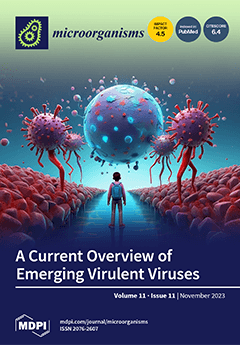The methanogenic strain Mx-05
T was isolated from the human fecal microbiome. A phylogenetic analysis based on the 16S rRNA gene and protein marker genes indicated that the strain is affiliated with the order
Methanomassiliicoccales. It shares 86.9% 16S rRNA gene sequence
[...] Read more.
The methanogenic strain Mx-05
T was isolated from the human fecal microbiome. A phylogenetic analysis based on the 16S rRNA gene and protein marker genes indicated that the strain is affiliated with the order
Methanomassiliicoccales. It shares 86.9% 16S rRNA gene sequence identity with
Methanomassiliicoccus luminyensis, the only member of this order previously isolated. The cells of Mx-05
T were non-motile cocci, with a diameter range of 0.4–0.7 μm. They grew anaerobically and reduced methanol, monomethylamine, dimethylamine, and trimethylamine into methane, using H
2 as an electron donor. H
2/CO
2, formate, ethanol, and acetate were not used as energy sources. The growth of Mx-05
T required an unknown medium factor(s) provided by
Eggerthella lenta and present in rumen fluid. Mx-05
T grew between 30 °C and 40 °C (optimum 37 °C), over a pH range of 6.9–8.3 (optimum pH 7.5), and between 0.02 and 0.34 mol.L
−1 NaCl (optimum 0.12 mol.L
−1 NaCl). The genome is 1.67 Mbp with a G+C content of 55.5 mol%. Genome sequence annotation confirmed the absence of the methyl branch of the H
4MPT Wood–Ljungdahl pathway, as described for other
Methanomassiliicoccales members. Based on an average nucleotide identity analysis, we propose strain Mx-05
T as being a novel representative of the order
Methanomassiliicoccales, within the novel family
Methanomethylophilaceae, for which the name
Methanomethylophilus alvi gen. nov, sp. nov. is proposed. The type strain is Mx-05
T (JCM 31474T).
Full article






